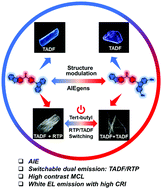Aggregation-state engineering and emission switching in D–A–D′ AIEgens featuring dual emission, MCL and white electroluminescence†
Abstract
Thermally activated delayed fluorescence (TADF) and room-temperature phosphorescence (RTP) have attracted much recent attention for their capabilities to utilize triplet excitons for emission. Herein, we demonstrate a strategy for switching between intermolecular TADF and RTP through rational structure modulation and crystal engineering with two newly designed organic AIEgens, namely (4-(9H-carbazol-9-yl)phenyl) (dibenzo[b,d]thiophen-2-yl)methanone (CTM) and (4-(3,6-di-tert-butyl-9H-carbazol-9-yl) phenyl) (dibenzo[b,d]thiophen-2-yl) methanone (tCTM). Both materials exhibit intramolecular TADF and intermolecular TADF/RTP dual emission in single crystals. High contrast mechanochromic luminescence (MCL) was unveiled due to the polymorphism of both emitters in aggregated states. Using these materials as emitters, we demonstrate for the first time, such dual TADF–TADF/RTP emissions can be exploited to obtain white light organic light-emitting diodes with high color rendering indexes.

- This article is part of the themed collection: Journal of Materials Chemistry C Lunar New Year collection 2021


 Please wait while we load your content...
Please wait while we load your content...